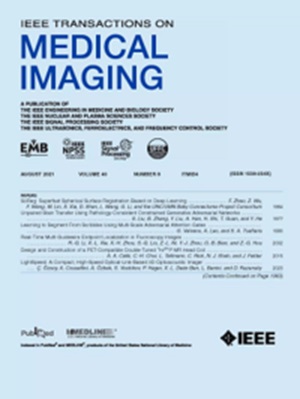基于生成对抗网络的马尔可夫链蒙特卡罗理想观测器计算
IF 8.9
1区 医学
Q1 COMPUTER SCIENCE, INTERDISCIPLINARY APPLICATIONS
引用次数: 0
摘要
医学成像系统通常通过客观的或特定任务的图像质量(IQ)测量来评估和优化,该测量量化了观察者在特定临床相关任务中的表现。贝叶斯理想观测者(IO)的性能在所有观测者中设定了上限,无论是数值观测者还是人类观测者,并且被提倡用作评估和优化医学成像系统的价值图(FOM)。然而,IO测试统计量对应于在大多数情况下难以计算的似然比。先前提出了一种基于采样的方法,采用马尔可夫链蒙特卡罗(MCMC)技术来估计IO性能。然而,目前MCMC方法在IO近似中的应用仅限于少数情况,其中待成像对象的考虑分布可以通过相对简单的随机对象模型(SOM)来描述。因此,仍然非常需要扩展MCMC方法的适用范围,以解决需要基于io的评估但尚未提供相关som的各种情况。在本研究中,描述和评估了一种新的MCMC方法,该方法采用了基于生成对抗网络(GAN)的SOM,称为MCMC-GAN。MCMC-GAN方法通过使用可获得参考溶液的测试用例进行了定量验证。结果表明,MCMC- gan方法可以扩展MCMC方法在医学成像系统IO分析中的适用范围。本文章由计算机程序翻译,如有差异,请以英文原文为准。
Ideal Observer Computation by Use of Markov-Chain Monte Carlo with Generative Adversarial Networks
Medical imaging systems are often evaluated and optimized via objective, or task-specific, measures of image quality (IQ) that quantify the performance of an observer on a specific clinically-relevant task. The performance of the Bayesian Ideal Observer (IO) sets an upper limit among all observers, numerical or human, and has been advocated for use as a figure-of-merit (FOM) for evaluating and optimizing medical imaging systems. However, the IO test statistic corresponds to the likelihood ratio that is intractable to compute in the majority of cases. A sampling-based method that employs Markov-Chain Monte Carlo (MCMC) techniques was previously proposed to estimate the IO performance. However, current applications of MCMC methods for IO approximation have been limited to a small number of situations where the considered distribution of to-be-imaged objects can be described by a relatively simple stochastic object model (SOM). As such, there remains an important need to extend the domain of applicability of MCMC methods to address a large variety of scenarios where IO-based assessments are needed but the associated SOMs have not been available. In this study, a novel MCMC method that employs a generative adversarial network (GAN)-based SOM, referred to as MCMC-GAN, is described and evaluated. The MCMC-GAN method was quantitatively validated by use of test-cases for which reference solutions were available. The results demonstrate that the MCMC-GAN method can extend the domain of applicability of MCMC methods for conducting IO analyses of medical imaging systems.
求助全文
通过发布文献求助,成功后即可免费获取论文全文。
去求助
来源期刊

IEEE Transactions on Medical Imaging
医学-成像科学与照相技术
CiteScore
21.80
自引率
5.70%
发文量
637
审稿时长
5.6 months
期刊介绍:
The IEEE Transactions on Medical Imaging (T-MI) is a journal that welcomes the submission of manuscripts focusing on various aspects of medical imaging. The journal encourages the exploration of body structure, morphology, and function through different imaging techniques, including ultrasound, X-rays, magnetic resonance, radionuclides, microwaves, and optical methods. It also promotes contributions related to cell and molecular imaging, as well as all forms of microscopy.
T-MI publishes original research papers that cover a wide range of topics, including but not limited to novel acquisition techniques, medical image processing and analysis, visualization and performance, pattern recognition, machine learning, and other related methods. The journal particularly encourages highly technical studies that offer new perspectives. By emphasizing the unification of medicine, biology, and imaging, T-MI seeks to bridge the gap between instrumentation, hardware, software, mathematics, physics, biology, and medicine by introducing new analysis methods.
While the journal welcomes strong application papers that describe novel methods, it directs papers that focus solely on important applications using medically adopted or well-established methods without significant innovation in methodology to other journals. T-MI is indexed in Pubmed® and Medline®, which are products of the United States National Library of Medicine.
 求助内容:
求助内容: 应助结果提醒方式:
应助结果提醒方式:


